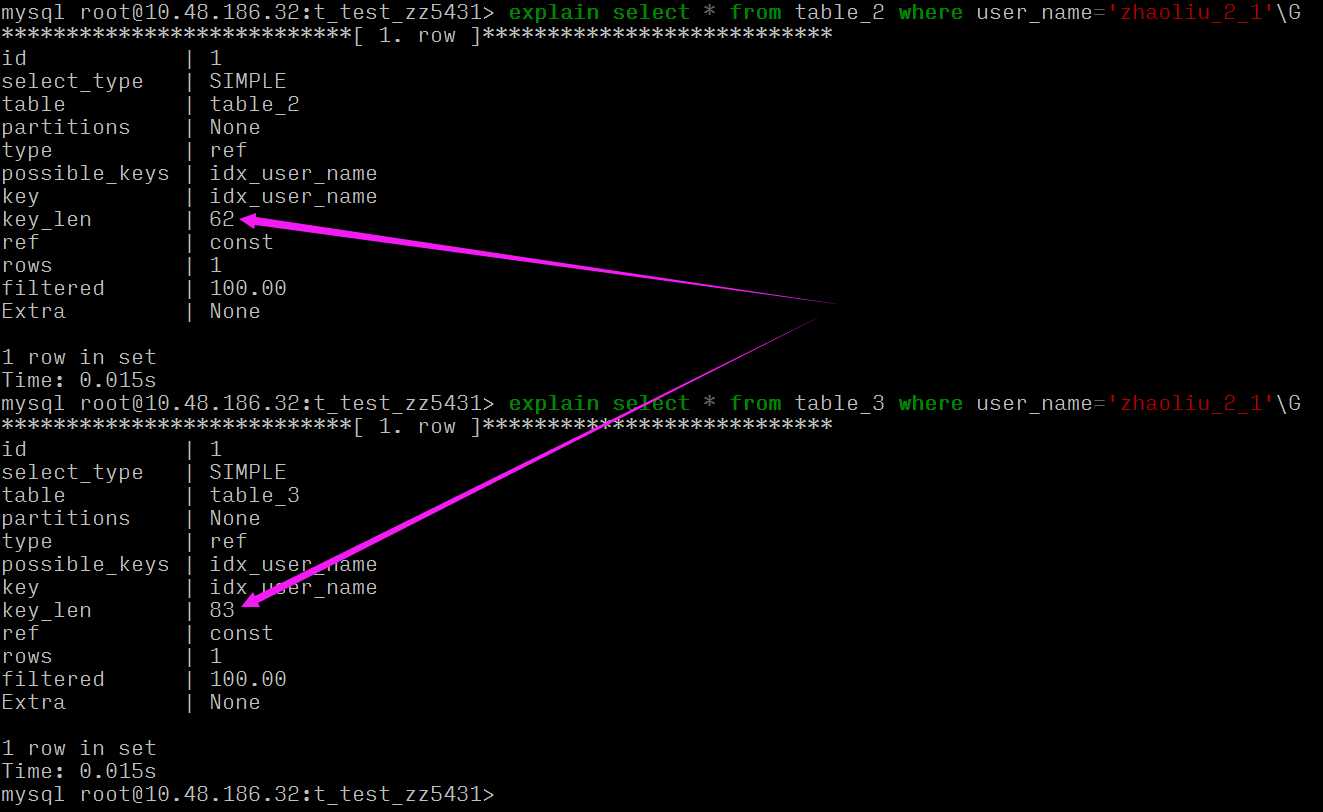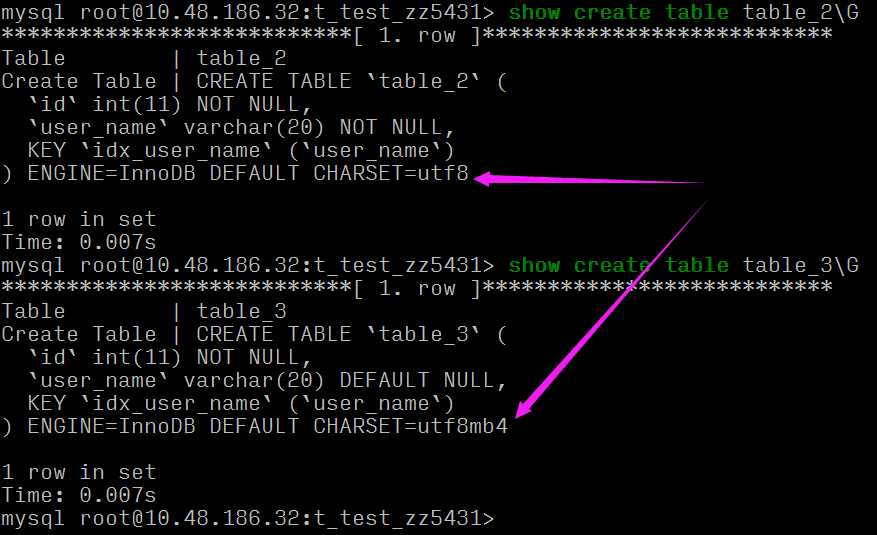标签:keyword 启用 ted possible 额外 字符编码 rest 复合 count
下面咱们要聊的是 MySQL 里的 null,在大量的 MySQL 优化文章和书籍里都提到了字段尽可能用NOT NULL,而不是NULL,除非特殊情况。但却都只给结论不说明原因,犹如鸡汤不给勺子一样,让不少初学者对这个结论半信半疑或者云里雾里。本文今天就详细的剖析下使用 Null 的原因,并给出一些不用 Null 的理由。
MySQL 官网文档:
NULL columns require additional space in the rowto record whether their values are NULL. For MyISAM tables, each NULL columntakes one bit extra, rounded up to the nearest byte.
Mysql难以优化引用可空列查询,它会使索引、索引统计和值更加复杂。可空列需要更多的存储空间,还需要mysql内部进行特殊处理。可空列被索引后,每条记录都需要一个额外的字节,还能导致MYisam 中固定大小的索引变成可变大小的索引。
—— 出自《高性能mysql第二版》
照此分析,还真不是以讹传讹,这是有理论依据和出处的。
注意:但把NULL列改为NOT NULL带来的性能提示很小,除非确定它带来了问题,否则不要把它当成优先的优化措施,最重要的是使用的列的类型的适当性。

create table table_2 (
`id` INT (11) NOT NULL,
user_name varchar(20) NOT NULL
)
create table table_3 (
`id` INT (11) NOT NULL,
user_name varchar(20)
)
insert into table_2 values (4,"zhaoliu_2_1"),(2,"lisi_2_1"),(3,"wangmazi_2_1"),(1,"zhangsan_2"),(2,"lisi_2_2"),(4,"zhaoliu_2_2"),(3,"wangmazi_2_2")
insert into table_3 values (1,"zhaoliu_2_1"),(2, null)
-- 1、NOT IN子查询在有NULL值的情况下返回永远为空结果,查询容易出错
select user_name from table_2 where user_name not in (select user_name from table_3 where id!=1)
mysql root@10.48.186.32:t_test_zz5431> select user_name from table_2 where user_name not
-> in (select user_name from table_3 where id!=1);
+-------------+
| user_name |
|-------------|
+-------------+
0 rows in set
Time: 0.008s
mysql root@10.48.186.32:t_test_zz5431>
-- 2、单列索引不存null值,复合索引不存全为null的值,如果列允许为null,可能会得到“不符合预期”的结果集
-- 如果name允许为null,索引不存储null值,结果集中不会包含这些记录。所以,请使用not null约束以及默认值。
select * from table_3 where name != ‘zhaoliu_2_1‘
-- 3、如果在两个字段进行拼接:比如题号+分数,首先要各字段进行非null判断,否则只要任意一个字段为空都会造成拼接的结果为null。
select CONCAT("1",null) from dual; -- 执行结果为null。
-- 4、如果有 Null column 存在的情况下,count(Null column)需要格外注意,null 值不会参与统计。
mysql root@10.48.186.32:t_test_zz5431> select * from table_3;
+------+-------------+
| id | user_name |
|------+-------------|
| 1 | zhaoliu_2_1 |
| 2 | <null> |
| 21 | zhaoliu_2_1 |
| 22 | <null> |
+------+-------------+
4 rows in set
Time: 0.007s
mysql root@10.48.186.32:t_test_zz5431> select count(user_name) from table_3;
+--------------------+
| count(user_name) |
|--------------------|
| 2 |
+--------------------+
1 row in set
Time: 0.007s
-- 5、注意 Null 字段的判断方式, = null 将会得到错误的结果。
mysql root@localhost:cygwin> create index IDX_test on table_3 (user_name);
Query OK, 0 rows affected
Time: 0.040s
mysql root@localhost:cygwin> select * from table_3 where user_name is null\G
***************************[ 1. row ]***************************
id | 2
user_name | None
1 row in set
Time: 0.002s
mysql root@localhost:cygwin> select * from table_3 where user_name = null\G
0 rows in set
Time: 0.002s
mysql root@localhost:cygwin> desc select * from table_3 where user_name = ‘zhaoliu_2_1‘\G
***************************[ 1. row ]***************************
id | 1
select_type | SIMPLE
table | table_3
type | ref
possible_keys | IDX_test
key | IDX_test
key_len | 23
ref | const
rows | 1
Extra | Using where
1 row in set
Time: 0.006s
mysql root@localhost:cygwin> desc select * from table_3 where user_name = null\G
***************************[ 1. row ]***************************
id | 1
select_type | SIMPLE
table | None
type | None
possible_keys | None
key | None
key_len | None
ref | None
rows | None
Extra | Impossible WHERE noticed after reading const tables
1 row in set
Time: 0.002s
mysql root@localhost:cygwin> desc select * from table_3 where user_name is null\G
***************************[ 1. row ]***************************
id | 1
select_type | SIMPLE
table | table_3
type | ref
possible_keys | IDX_test
key | IDX_test
key_len | 23
ref | const
rows | 1
Extra | Using where
1 row in set
Time: 0.002s
mysql root@localhost:cygwin>

alter table table_3 add index idx_user_name (user_name);
alter table table_2 add index idx_user_name (user_name);
explain select * from table_2 where user_name=‘zhaoliu_2_1‘;
explain select * from table_3 where user_name=‘zhaoliu_2_1‘;
可以看到同样的 varchar(20) 长度,table_2 要比 table_3 索引长度大,这是因为:
两张表的字符集不一样,且字段一个为 NULL 一个非 NULL。

key_len 的计算规则和三个因素有关:数据类型、字符编码、是否为 NULL
key_len 62 == 20*3(utf8 3字节) + 2 (存储 varchar 变长字符长度 2字节,定长字段无需额外的字节)
key_len 83 == 20*4(utf8mb4 4字节) + 1 (是否为 Null 的标识) + 2 (存储 varchar 变长字符长度 2字节,定长字段无需额外的字节)
所以说索引字段最好不要为NULL,因为NULL会使索引、索引统计和值更加复杂,并且需要额外一个字节的存储空间。基于以上这些理由和原因,我想咱们不用 Null 的理由应该是够了 :)
转自:https://my.oschina.net/leejun2005/blog/1342985
标签:keyword 启用 ted possible 额外 字符编码 rest 复合 count
原文地址:https://www.cnblogs.com/itplay/p/11401497.html